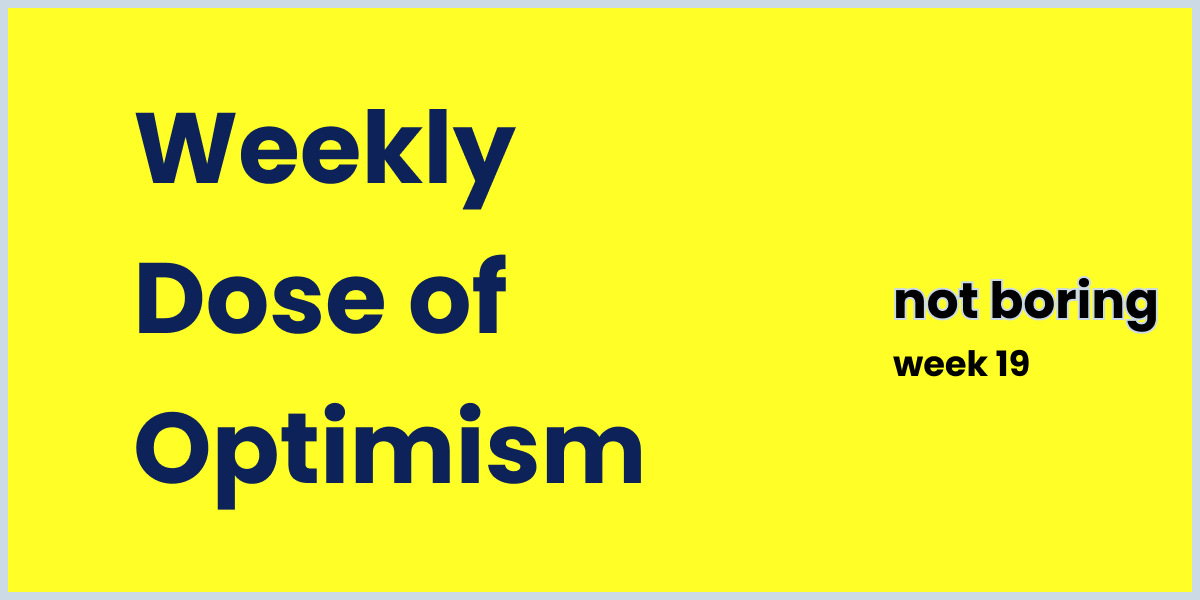

Weekly Dose of Optimism #19
source link: https://www.notboring.co/p/weekly-dose-of-optimism-19
Go to the source link to view the article. You can view the picture content, updated content and better typesetting reading experience. If the link is broken, please click the button below to view the snapshot at that time.

Weekly Dose of Optimism #19
Meta's Protein, It's Time to Space, Nuclear Brief, RSV Vaccine, Stripe Layoffs, AI Portraits
Hi friends 👋,
Happy Friday and welcome to our 19th Weekly Dose of Optimism. Once again: go Phils.
The Weekly Dose is brought to you by… Composer
Luck isn’t an investment strategy. If you’ve read Not Boring for a while, you’re familiar with Composer — the investment app that let’s you easily build sophisticated trading strategies. Since founding its algorithmic trading platform in 2020, Composer has helped over 20,000 customers trade 100s of millions of dollars. I’m one of them — after finally admitting I’m a terrible trader, I’ve moved my public markets investing to Composer’s automated strategies.
Composer has synthesized all of this data, sifting through what works (and, importantly, what doesn’t) to create its most powerful investing solution yet: Opus. Put simply, Opus is a quantitative tool built on Composer’s vast pool of data with just one goal in mind: maximize risk-adjusted returns. Opus by Composer can help you, as a retail investor, close the gap.
It’s easy to get started. Just choose your volatility level and start investing in Opus.
(1) AlphaFold’s new rival? Meta AI predicts shape of 600 million proteins
Ewen Callaway for Nature
Researchers at Meta (formerly Facebook, headquartered in Menlo Park, California) have used artificial intelligence (AI) to predict the structures of some 600 million proteins from bacteria, viruses and other microbes that haven’t been characterized.
It’s been a tough few weeks (months? quarters? years?) for Meta. Negative headlines, whistleblowing, stock volatility — you name it. So it can be easy to forget that the social media giant is also one of the world’s largest long-term investors in AI research. Sure, most of that AI will be used to fine tune Reels recommendations or target ads or make the Metaverse more performant — but the underlying research can also be applied to deep scientific research.
Zuck has been one of the larger patrons of science over the last decade and his foundation, The Chan Zuckerberg Initiative, has the goal of “managing all diseases” by the end of the 21st century. To do so, they’ll inevitably need major advancements in how we understand the body at the molecular level. AI can be really useful here.
Meta’s model predicts the shape of ~600 million proteins, nearly three times as many as the ~220 million protein structures DeepMind unveiled earlier this year. The delta was driven by Meta’s model identifying proteins from bacteria, viruses, and other microbes that hadn’t yet been characterized. While Meta’s model is not at as accurate as DeepMind’s, it’s about 60x faster, which enables it to run on much larger databases. “Move fast and break things with stable infrastructure.”
This is the type of Big Tech competition we can get behind.
(2) Why America Must Develop Space, and How We’ll Do It
Ryan McEntush for a16z.com
Space is far too important to simply cede development to others. Control of this new sea and development of the space industrial base are paramount toward the continued strength of the United States, and the prolonging of a world of free markets and liberal democracies. At the end of the day, this seismic effort requires the might of a strong, skillful, and, most of all, determined population. As a nation, we can accomplish this task ahead of us. That one small step might spawn another, then cast us forward into a stride — expanding our civilization into the pantheon of the heavens.
a16z (where I’m an advisor on the Crypto team) is making a big push into space as part of its American Dynamism practice. At Not Boring, we partnered with Payload Space to publish a full breakdown of The Space Economy which chronicles the development of the space industry, analyzes its value chain, and highlights some of the major players in the ecosystem. Our analysis put a spotlight on growing competition between the U.S. and the Sino-Russian space alliance, but this piece goes a few important steps further. It plants a flag in the investment world that:
Space is an important battleground of the New Cold War,
We need public, private, and public-private investment into space to compete on that battleground, and
Now is a good time to invest in that future.
a16z has a history of publishing these paradigm shifting pieces, including: Why Software is Eating the World (2011), Why Bitcoin Matters (2014), It’s Time to Build (2020), Building American Dynamism (2022). If the aftermath of those pieces is any indication, IT’S TIME TO INVEST IN SPACE.
(3) Nuclear energy: past, present and future
By Julia DeWahl
Despite these challenges, nuclear energy’s carbon-free, 24/7 qualities make it undeniably attractive to meet the demands of clean, firm power, where both fossil fuels and renewables fall short. There have been a number of promising developments for nuclear energy this year and the ‘why now’ for nuclear is strong.
This nuclear energy deep dive from Julia DeWahl is the most digestible breakdown of nuclear energy’s past, present, and future we’ve come across.
Past: It’s actually quite frustrating to see how flimsy the anti-nuclear argument is. Flimsy in that the anti-nuclear movement gained momentum due to some combination of poor word association, over-blown media reactions (exactly zero (0) people died at Three Mile Island), and NIMBYism. Frustrating in that the nuclear stigma prevented ~50 years of the world fully using and innovating on a high-potential clean energy source.
Present: The U.S. relies on nuclear more than you’d imagine — over 20% of the electricity and over 50% of carbon-free electricity we use comes from nuclear. The case for nuclear can be made in three points: it’s clean, safe, and efficient. But nuclear also faces some challenges, namely: regulation, pervasive stigma, and rising infrastructure costs.
Future: We need to both combat climate change and generate more energy; nuclear is well-positioned to establish itself as a long-term smart choice for clean energy. It’ll need to overcome some regulatory issues, continue its PR campaign, and decrease costs (small modular reactors, which we mentioned here, are making headway on this front).
Abundant clean, cheap energy is one of the biggest unlocks available to humanity. We want all the solar, wind, geothermal, hydro, and nuclear we can get our hands on.
Brenda Goodman for CNN
“The [study data monitoring committee] recommended, based on the data that we have, that we should go ahead and file, that this offers the potential for a safe and effective vaccine that could really dramatically help to prevent RSV during the winter season,” Dr. William Gruber, Pfizer’s senior vice president of vaccine clinical research and development, told CNN.
This one hits close to home. Dev just got over RSV. Maya has it. Pretty much everyone we know with kids is going through the same thing right now. And we’re not alone, there is a surge in RSV cases in the US.
So the news that Pfizer’s RSV vaccine trials were successful enough to prompt the company to apply to for FDA approval is more than welcomed. The vaccine’s trial results were impressive: reducing serious RSV in a baby’s first 3 months by 80% and reducing the likelihood of a baby needing to see a doctor by 50%. Depending on FDA timelines, the vaccine could be out in the wild before next winter.
(5) CEO Patrick Collison's email to Stripe employees
Patrick Collison for Stripe
While the changes today are painful, we feel very good about the prospects for innovative businesses and about Stripe’s position in the internet economy. The data we see is consistent with this encouraging picture: we signed a remarkable 75% more new customers in Q3 2022 than Q3 2021, our competitive win rates are getting even better, our growth rates remain very strong, and on Tuesday we set a new record for total daily transaction volume processed. Our smaller users (many of whom are just “big customers that aren’t yet big”) are, in aggregate, growing extremely quickly, showing that plenty of technology S curves remain in the early innings and that our customers remain impressively resilient in the face of the broader global challenges.
As we’ve discussed previously, layoffs are never a cause for celebration. They suck. Aside from the obvious fact that people getting fired en masse is not pleasant, much of the ickiness is the result of how company managers handle the process. Some CEOs handle it like this. Others, like Patrick Collison, handle it with a bit more tact and generosity.
But layoffs can also be positive in the longer-term, for the companies, the people laid off, and the wider ecosystem. Aside from the thoughtful executive comms and plush exit packages, I think there are two optimistic takes to be harvested from this otherwise gloomy note:
Internet Commerce Growth: Despite massive macroeconomic challenges, Stripe grew new customers 75% YoY in Q3 and recently set a record for daily transaction volume. Commerce on the internet breeds opportunity, and that opportunity is still growing quickly.
Schumpeter’s Gale: In addition to one of the more generous severance packages I’ve ever seen (14 weeks, unpaid PTO, bonuses, accelerated vesting cliffs, healthcare, career support), all 1,000 of the former employees now have Stripe on their resumes (and an alumni.stripe.com email address). That’s 1,000 ex-Stripes looking to bring their skills, networks, and pedigree to the next wave of startups. Some will start new companies, many will join younger startups and bring with them experience in scaling thoughtfully. The Stripes’ surface area will increase.
Plus, layoffs are generally just the beginning — going forward, Stripe will slow down hiring after nearly 4x’ing staff in the last few years. Stripe probably didn’t lay off its 10x engineers, but it will be less aggressive in competing for the next batch of them. Without Big Tech, Stripe included, aggressively recruiting to fill massive hiring quotas, startups may have the opportunity to compete for the very best talent.
BONUS: Portrait by Vana
Not Boring Capital portfolio company, Vana, is getting in on the Generative AI action with the release of Portrait. Very simple to use and and impressive end-product: just upload 8 images of your face, Vana develops a generative art model for you, and voila: a few hours later, you have a gallery of AI-generated portraits emailed to you. Here’s one of mine:
Give it a try and tweet your favorite result @notboringco. We’ll retweet a few of our favorites and share some in next week’s Weekly Dose.
That’s all for this week. Next Friday will be our 20th straight Weekly Dose of Optimism. Ahead of that, if you enjoyed this edition, we’d really appreciate if you shared it with a friend, family member or colleague.
We’ll be back in your inbox 9am EST on Monday morning. Enjoy the weekend.
Packy
Recommend
About Joyk
Aggregate valuable and interesting links.
Joyk means Joy of geeK





